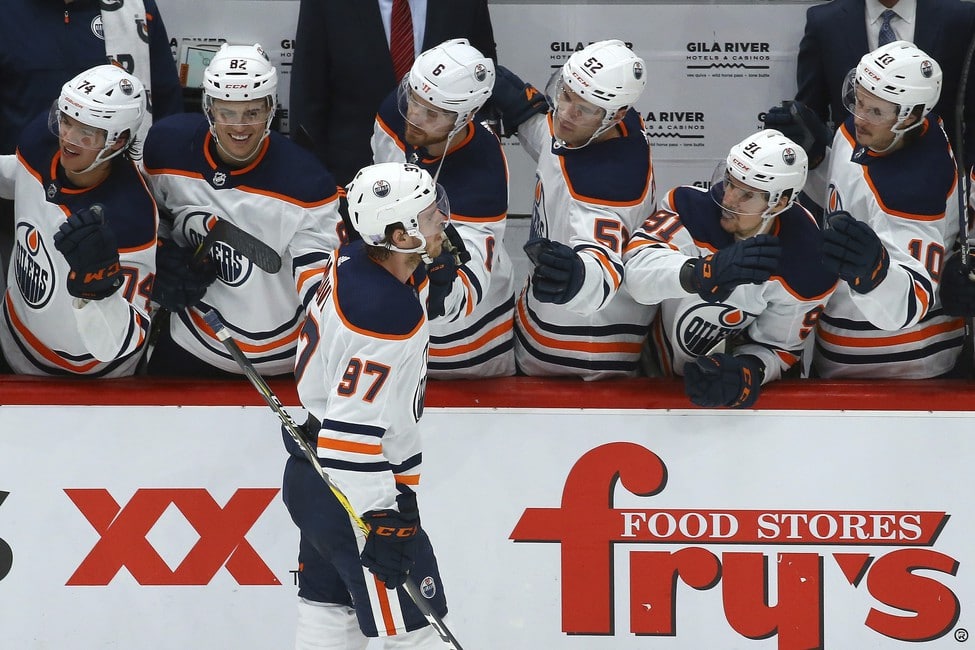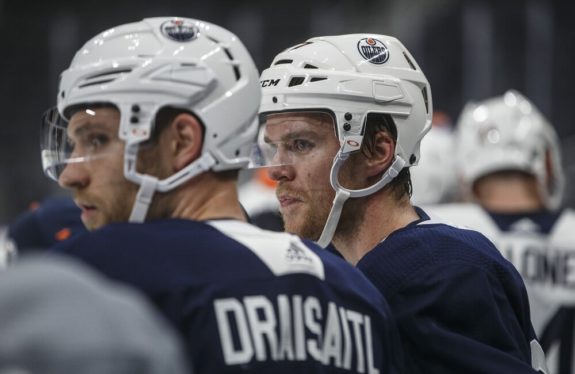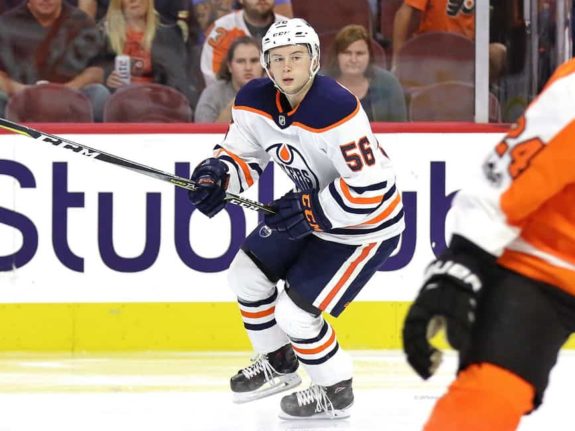
The 2016-17 season was a good time to be an Oilers fan, at the start of the year, Peter Chiarelli made multiple transactions in an attempt to get his team stronger and more consistent. Taylor Hall was traded for Adam Larsson, and Milan Lucic signed a seven-year contract with the team. Eric Gryba and Matt Benning also signed short-term deals with the club. The season would end up being an excellent one for the blue and orange. Led by Connor McDavid, Leon Draisaitl and Cam Talbot, the Oilers finished second in their division with 103 points. After defeating San Jose in round one of the playoffs, the Oilers had an entertaining second round with the Anaheim Ducks. The series ended up going the full seven games and although Anaheim came out on top the Oilers served notice to the league that they were on the rise.
Unfortunately, in the following season that ended up not being the case. After trading Jordan Eberle, buying out Benoit Pouliot and Andrej Sekera, the Oilers never looked like the dynamic 2016-17 team that showed so much promise and ended up missing the playoffs from 2018-2020.
The 2020-21 Oilers are looking to be on track to make the playoffs for the first time since 16-17, the question is, are they as good as the beloved 2016-17 team? Join me as I start a two-part series breaking down both teams and how they stack up to one another. Today I will be breaking down the forward lines on both teams and declaring who has the better group.
First Line
2016-2017: Patrick Maroon-McDavid-Draisaitl
2020-21: Ryan Nugent Hopkins-McDavid-Jesse Puljujarvi
In 2016-17, the Oilers were powered by their first line, in his first full season, Connor McDavid lit up the league for 100 points and won his first (but not last) Hart Trophy. Leon Draisaitl also proved his doubters wrong when he put up 77 points while riding shotgun to McDavid. The biggest surprise on that line was 28-year-old, Patrick Maroon. He set career highs of 27 goals and 42 points while also occasionally standing up for his two superstar linemates.

So far in 2020-21, the first line has one of, if not, the most consistent for the orange and blue. Amazingly McDavid is currently on pace to have more points in 56 games this year, than in 82 games in 2016-17. McDavid has also improved his defensive game greatly after many heated debates in the offseason between fans about how good his two-way game is. There is no doubt that McDavid has matured greatly since his 2016-17 break out, but the 2020-21 version is clearly the better player.
That leads me to Nugent-Hopkins, who rides shotgun on McDavid’s left wing. He has really upped his game the past few years, as he has 148 points in 167 games since the start of the 2018-2019 season. He has been the perfect complement to either McDavid or Draisaitl as he plays an underrated two-way game that is offensively talented and defensively responsible. He is a definite upgrade over Maroon.
The last member of the top line is Finnish winger, Puljujarvi. After agreeing to come back to Edmonton on a two-year deal this summer, Puljujarvi came to training camp with a new and improved attitude. He started on the third line but has recently worked his way onto the top line. So far, he has been a great fit with McDavid and RNH. In his 10 games with them, he has six points, good production for a supporting player. Puljujarvi also provides solid defensive play and he is a pain for opposing teams in front of the net.

He has also earned the trust of head coach Dave Tippett to put him out in tense moments, which is a great sign for a young player. Despite his good play he still has tons of potential to uncap and it will be very interesting to see if he can live up to his number four selection hype. Although Puljujarvi has been amazing for the Oilers this season, 2016-17 Draisaitl was a much better winger and will likely always be.
Second Line
2016-2017: Lucic-Nugent-Hopkins-Eberle
2020-21- Dominik Kahun-Draisaitl-Kailer Yamamoto
When the Oilers made their first playoff appearance in 11 years, it was not just because of their top line. They had valuable secondary scoring. A newly signed Lucic was placed on the second line after losing his spot on McDavid’s wing to Maroon. Lucic fit in well in his first year as an Oiler. He had 50 points in total including 27 power-play points. He provided a physical presence and was willing to drop the gloves to stand up for a teammate.
As a result of that, Eberle was able to play without being worried about being crushed against the boards. That led him to produce 51 points that season, including 20 goals. He also provided some veteran leadership to a relatively young Oilers squad. Eberle finished plus-3 on the year after being a minus player for four of his five previous seasons.
The final member of the 2016-17 Oilers second line is center, Nugent-Hopkins. Although it would be hard to imagine right now, RNH had a season to forget in 2016-17. He scored just 43 points in 82 games, by far the lowest points per game in his career. Despite having almost two minutes of power-play time per game he only got 11 points and finished that year a minus-10. Although he had a tough year, there were some positives to take away from his season. He was a big part of the penalty kill, which finished at 80.7%. “Nuge” also focused on improving his two-way game, and has been on the rise ever since.

After winning the Hart trophy last year as the league’s best player, Draisaitl has not slowed down since. In 20 games this season he has produced 30 points including 10 goals, good for fifth in the league. Even though he was placed on the second line, he is still producing like a superstar. After many people claimed that he did not deserve to win the Hart because he did not play defense he has responded to those claims very well this season. He is top 10 in both takeaways and faceoff percentage. Draisaitl is a clear boost from 2016-17 RNH because of his ability to produce points at a much higher rate.
Kahun is Draisaitl’s new linemate, and countryman. Kahun only has eight points in 21 games this season but he has done much more. His greatest ability is retrieving pucks in the offensive zone and he has done a great job of that this season. His perseverance and work effort have kept him on this line thought this season. Although Kahun has been very underrated this season, I have to give the advantage to 2016-17 Lucic as he produced points at a higher rate and provided physical play when needed. Something Kahun has yet to do.
The last piece of the second line is the “Honey Badger,” Yamamoto. Since coming up from the AHL last season, he has been everything the Oilers could dream of him. In total, he has 35 points in 47 games and has been the hardest working player on the team usually every game. He always provides a spark to the team by showing his fearlessness when he gets right up in opposing players’ faces and being tenacious in all three zones of the ice.

What’s impressive is that all but his two points are even strength. Yamamoto has also earned the trust of Tippett to put him on the PK and late in games. He is clearly superior to 2016-17 Eberle because of his commitment to defensive play and dogged forecheck.
Bottom six
2016-2017: Drake Caggiula-Mark Letestu-Zack Kassian
Benoit Pouliot-David Desharnais-Anton Slepyshev
Matt Hendricks-Tyler Pitlick
2021: Tyler Ennis-Jujhar Khaira-Josh Archibald
Alex Chaisson-Gaetan Hass-Kassian
James Neal-Kyle Turris
Both of these bottom six groups have a lot of similarities, the Oilers management is finally learning that you can’t win games based on two lines. When the Oilers are winning games, they have production from the entire lineup. Sure, you might have the occasional McDavid/Draisaitl explosion but you cannot count on it. This season alone, of their 12 wins, 10 of them come when a bottom-six player has scored. In the 2016-17 season, that was the same result. The Oilers got production from their bottom six and they won. In that season they got 138 points from their bottom six, including 35 from veteran center Letestu.

Those players need to provide energy. It could be in any form. It could be a goal, or a big hit, or even a gutsy shot block. These players also usually find ways to contribute to the special teams. Whether it’s on the penalty kill or even the power play, they must do what’s expected on the special teams. For example, on the 2016-17 team, four of the six players played on the power play and all of them played on the penalty kill.
This year thanks to the taxi squad, the Oilers can hold an extra seven players on their team. (from ‘OILERS SNAPSHOTS: Taxi squad helping Edmonton Oilers reach the NHL fast lane,’ Edmonton Sun, 02/24/2021) Whenever one of these players comes in for a game we always see them play with tenacity and perseverance. If the Oilers keep that mindset up they will have more depth and confidence to turn to anyone on the taxi squad. Tippett will have more confidence to put them out there and that’s never a bad thing.
Even though general manager Ken Holland has done a good job of improving the bottom six, I have to say that the 2016-17 Oilers’ was better. Tippett is still tinkering with his bottom six and there is no fixed lineup. Time and time again Oilers fans are up in arms(on social media) because someone like Turris is played over Haas, or Neal over Ennis. Until Tippett shows that he can make the right decisions consistently, this bottom 6 will not be as good as the 2016-17 group.
Which Team Has the Better Forward Group?
In conclusion, I have to say that this year’s Oilers have the better forward group. They have kept their core together and it has paid off. McDavid, Draisaitl and Nugent-Hopkins have all become much better players than they were in 2016-17. They have great support players who are relentless on the forecheck and are consistent in their play every night. Although the 2016-17 bottom-six group is better there have been encouraging signs of life so far this season. Players like Ennis, Archibald, Khaira and Chaisson have all had stretches of great play throughout the season and if they can keep it up the Oilers will be a tough team to play against.
